- Home
- Ernest Hemingway
Death in the Afternoon Page 13
Death in the Afternoon Read online
Page 13
A bull that has gored a man becomes much more liable to gore again. A great part of the matadors who have been gored and killed in the ring have been caught and tossed previously by the bull that finally killed them. Of course many times this repetition of the goring in the course of the same fight is due to the man being shocked into grogginess or deprived of his agility or judgment of distance by the first tossing, but it is also true that a bull which has found the man under the lure or after the placing of a pair of banderillas, will repeat the process by which he caught him. He will give a sudden chop with his head as he passes the man while following the cape or muleta, or a braking with his feet in the centre of the charge, or a swerving from the cloth toward the man with his horn or whatever act it was which caught the man the first time. Similarly there are certain strains even of bulls in which the ability to learn rapidly in the ring is highly developed. These bulls must be fought and killed as rapidly as possible with the minimum of exposure by the man, for they learn more rapidly than the fight ordinarily progresses and become exaggeratedly difficult to work with and kill.
Bulls of this sort are the old caste of fighting bulls raised by the sons of Don Eduardo Miura of Sevilla, although the sons of that most scrupulous bull breeder have tried to make their bulls less dangerous and more acceptable to the bullfighters by crossbreeding with bulls of the Vistahermosa strain, the noblest, bravest and most candid of all the strains, and have succeeded in turning out bulls that have the imposing size, horns, and all the other appearance of the old deadly Miuras without their ferocious and crescient intelligence which made them the curse of all bullfighters. There is a breed of bulls which have the old Miura caste, blood, stature, power and fierceness that are raised in Portugal by Don José Palha, and if you ever see a bullfight with them advertised you will see what bulls can be at their fiercest, most powerful and most dangerous. They say that the Palha range where the mature bulls pasture is twelve kilometres from the water, I do not vouch for this, and that the bulls develop their great strength, wind and staying power by having to go so far for water. This was told me by a cousin of Palha, but I have never checked up on it.
As certain strains of fighting bulls will be particularly stupid and brave and others intelligent and brave, others will have different characteristics which are highly individual and yet will persist in most of the bulls of that breed. The bulls formerly bred and owned by the Duke of Veragua were examples of this. They were at the beginning of this century and for years after, among the bravest, strongest, fastest and finest looking of all the bulls of the Peninsula. But what were only minor tendencies twenty years earlier finally came to be the dominant characteristics of the whole strain. When they were nearly perfect bulls one of their first characteristics was a great rush of speed in the first third of the fight which left the bull rather winded and logy at the end. Another characteristic was that once a Veragua had caught and gored a man or a horse he would not leave him but would attack again and again, seeming to want to destroy his victim entirely; but they were very brave, willing to charge, and followed cape and muleta well. In twenty years there was almost nothing left of the original good qualities except the first speed in charging, while the tendency to become heavy and leaden as the fight went on was so exaggerated that a Veragua bull was almost dead on its feet after the first contact with the picadors. The tendency to keep on after a victim persisted, greatly exaggerated, but the speed, strength and bravery were all decreased to the minimum. In this way great strains of bulls will decrease in value for fighting in spite of the care and scruples of the breeder. He will try crossing with other strains, the only remedy, and sometimes these will be successful and there will be a new good strain, but more often they will cause the breed to disintegrate even more rapidly and lose whatever good characteristics it had.
An unscrupulous bull breeder can buy the bulls of a good breed and by profiting by their reputation for good presentation and bravery and himself selling everything with horns that is not a cow as a bull, destroy the good name of the breed and make a certain amount of money in a few years. He will not destroy the value of the breed as long as the blood remains good and the bulls have pasture and water that are good for them. A scrupulous breeder can take the same bulls and by testing them carefully and selling only those for fights which show bravery re-establish the breed in a short time. But when the blood that made the reputation of a breed goes thin, and defects that were only minor characteristics become dominant, then a breed, except for the occasional good bull that will be produced as an exception, is finished unless revived by a lucky and dangerous cross. I saw the last of the good bulls, the fast decay and the finish of the Veragua breed, and it was sad to watch. The present Duke sold them finally and the new owners are trying to revive the strain again.
Half-bred bulls or bulls in which there is a little fighting bull blood, called moruchos in Spanish, are often very brave while calves, showing the best characteristics of fighting stock, but as they reach maturity they lose all bravery and style and are altogether unfit for the ring. This falling off in bravery and style on complete maturity is characteristic of all bulls in which the fighting strain is mixed with ordinary blood and is the principal difficulty the Salamanca breeders face. There it is not the result of half-caste breeding, but is rather a characteristic seemingly inherent in bulls bred and pastured in that country. As a result if the Salamanca breeder wishes his bulls to come out with the maximum of bravery he must sell them young. These immature bulls have done more harm to bullfighting in every way than almost any other influence.
The main strains from which most of the best of the present-day breeds of bulls come, directly or through various crossings, are those of Vasquez, Cabrera, Vista Hermosa, Saavedra, Lesaca and Ibarra.
The breeders who furnish the best bulls to-day are the sons of Pablo Romero of Sevilla, the Conde de Santa Coloma of Madrid, Conde de la Corte of Badajoz, Doña Concepcion de la Concha y Sierra of Sevilla, daughter of the famous widow of Concha y Sierra; Doña Carmen de Federico, of Madrid, present owner of the Murube breed; the sons of Don Eduardo Miura of Sevilla, Marques de Villamarta of Sevilla, Don Argimiro Perez Tabernero, Don Gracialano Perez Tabernero and Don Antonio Perez Tabernero, all of Salamanca; Don Francisco Sanchez of Coquilla in the province of Salamanca, Don Florentino Sotomayor of Cordoba, Don José Pereira Palha of Villafranca de Xifra, Portugal, the widow of Don Felix Gomez of Colmenar Viejo, Doña Enriqueta de la Cova of Sevilla, Don Felix Moreno Ardanuy of Sevilla, Marques de Albayda of Madrid, and Don Julian Fernandez Martinez of Colmenar Viejo, who owns the old breed of Don Vicente Martinez.
There is not a word of conversation in the chapter, Madame, yet we have reached the end. I'm very sorry.
No sorrier than I am, sir.
What would you like to have? More major truths about the passions of the race? A diatribe against venereal disease? A few bright thoughts on death and dissolution? Or would you care to hear the author's experience with a porcupine during his earliest years spent in Emmett and Charlevoix counties in the state of Michigan?
Please, sir, no more about animals to-day.
What do you say to one of those homilies on life and death that delight an author so to write?
I cannot truly say I want that either. Have you not something of a sort I've never read, amusing yet instructive? I do not feel my best to-day.
Madame, I have the very thing you need. It's not about wild animals nor bulls. It's written in popular style and is designed to be the Whittier's Snow Bound of our time and at the end it's simply full of conversation.
If it has conversation in it I would like to read it.
Do so then, it's called -------
A NATURAL HISTORY OF THE DEAD
Old lady: I don't care for the title.
Author: I didn't say you would. You may very well not like any of it. But here it is:
A Natural History of the Dead
It has always seemed to me that the war has been omitted as a f
ield for the observations of the naturalist. We have charming and sound accounts of the flora and fauna of Patagonia by the late W. H. Hudson; the Reverend Gilbert White has written most interestingly of the Hoopoe on its occasional and not at all common visits to Selborne and Bishop Stanley has given us a valuable, although popular, Familiar History of Birds. Can we not hope to furnish the reader with a few rational and interesting facts about the dead? I hope so.
When that persevering traveller, Mungo Park, was at one period of his course fainting in the vast wilderness of an African desert, naked and alone, considering his days as numbered and nothing appearing to remain for him to do but to lie down and die, a small moss-flower of extraordinary beauty caught his eye. "Though the whole plant," says he, "was no larger than one of my fingers, I could not contemplate the delicate conformation of its roots, leaves and capsules without admiration. Can that Being who planted, watered and brought to perfection, in this obscure part of the world, a thing which appears of so small importance, look with unconcern upon the situation and suffering of creatures formed after his own image? Surely not. Reflections like these would not allow me to despair; I started up and, disregarding both hunger and fatigue, travelled forward, assured that relief was at hand; and I was not disappointed."
With a disposition to wonder and adore in like manner, as Bishop Stanley says, can no branch of Natural History be studied without increasing that faith, love and hope which we also, every one of us, need in our journey through the wilderness of life? Let us therefore see what inspiration we may derive from the dead.
In war the dead are usually the male of the human species although this does not hold true with animals, and I have frequently seen dead mares among the horses. An interesting aspect of war, too, is that it is only there that the naturalist has an opportunity to observe the dead of mules. In twenty years of observation in civil life I had never seen a dead mule and had begun to entertain doubts as to whether these animals were really mortal. On rare occasions I had seen what I took to be dead mules, but on close approach these always proved to be living creatures who seemed to be dead through their quality of complete repose. But in war these animals succumb in much the same manner as the more common and less hardy horse.
Old lady: I thought you said it wasn't about animals.
Author: It won't be for long. Be patient, can't you? It's very hard to write like this.
Most of those mules that I saw dead were along mountain roads or lying at the foot of steep declivities whence they had been pushed to rid the road of their encumbrance. They seemed a fitting enough sight in the mountains where one was accustomed to their presence and looked less incongruous there than they did later, at Smyrna, where the Greeks broke the legs of all their baggage animals and pushed them off the quay into the shallow water to drown. The numbers of broken-legged mules and horses drowning in the shallow water called for a Goya to depict them. Although, speaking literally, one can hardly say that they called for a Goya since there has only been one Goya, long dead, and it is extremely doubtful if these animals, were they able to call, would call for pictorial representation of their plight but, more likely, would, if they were articulate, call for some one to alleviate their condition.
Old lady: You wrote about those mules before.
Author: I know it and I'm sorry. Stop interrupting. I won't write about them again. I promise.
Regarding the sex of the dead it is a fact that one becomes so accustomed to the sight of all the dead being men that the sight of a dead woman is quite shocking. I first saw inversion of the usual sex of the dead after the explosion of a munition factory which had been situated in the countryside near Milan, Italy. We drove to the scene of the disaster in trucks along poplar-shaded roads, bordered with ditches containing much minute animal life, which I could not clearly observe because of the great clouds of dust raised by the trucks. Arriving where the munition plant had been, some of us were put to patrolling about those large stocks of munitions which for some reason had not exploded, while others were put at extinguishing a fire which had gotten into the grass of an adjacent field, which task being concluded, we were ordered to search the immediate vicinity and surrounding fields for bodies. We found and carried to an improvised mortuary a good number of these and, I must admit, frankly, the shock it was to find that these dead were women rather than men. In those days women had not yet commenced to wear their hair cut short, as they did later for several years in Europe and America, and the most disturbing thing, perhaps because it was the most unaccustomed, was the presence and, even more disturbing, the occasional absence of this long hair. I remember that after we had searched quite thoroughly for the complete dead we collected fragments. Many of these were detached from a heavy, barbed-wire fence which had surrounded the position of the factory and from the still existent portions of which we picked many of these detached bits which illustrated only too well the tremendous energy of high explosive. Many fragments we found a considerable distance away in the fields, they being carried farther by their own weight. On our return to Milan I recall one or two of us discussing the occurrence and agreeing that the quality of unreality and the fact that there were no wounded did much to rob the disaster of a horror which might have been much greater. Also the fact that it had been so immediate and that the dead were in consequence still as little unpleasant as possible to carry and deal with made it quite removed from the usual battlefield experience. The pleasant, though dusty, ride through the beautiful Lombard countryside also was a compensation for the unpleasantness of the duty and on our return, while we exchanged impressions, we all agreed that it was indeed fortunate that the fire which broke out just before we arrived had been brought under control as rapidly as it had and before it had attained any of the seemingly huge stocks of unexploded munitions. We agreed too that the picking up of the fragments had been an extraordinary business; it being amazing that the human body should be blown into pieces which exploded along no anatomical lines, but rather divided as capriciously as the fragmentation in the burst of a high explosive shell.
Old lady: This is not amusing.
Author: Stop reading it then. Nobody makes you read it. But please stop interrupting.
A naturalist, to obtain accuracy of observation, may confine himself in his observations to one limited period and I will take first that following the Austrian offensive of June, 1918, in Italy as one in which the dead were present in their greatest numbers, a withdrawal having been forced and an advance later made to recover the ground lost so that the positions after the battle were the same as before except for the presence of the dead. Until the dead are buried they change somewhat in appearance each day. The color change in Caucasian races is from white to yellow, to yellow-green, to black. If left long enough in the heat the flesh comes to resemble coal-tar, especially where it has been broken or torn, and it has quite a visible tarlike iridescence. The dead grow larger each day until sometimes they become quite too big for their uniforms, filling these until they seem blown tight enough to burst. The individual members may increase in girth to an unbelievable extent and faces fill as taut and globular as balloons. The surprising thing, next to their progressive corpulence, is the amount of paper that is scattered about the dead. Their ultimate position, before there is any question of burial, depends on the location of the pockets in the uniform. In the Austrian army these pockets were in the back of the breeches and the dead, after a short time, all consequently lay on their faces, the two hip pockets pulled out and, scattered around them in the grass, all those papers their pockets had contained. The heat, the flies, the indicative positions of the bodies in the grass and the amount of paper scattered are the impressions one retains. The smell of a battlefield in hot weather one cannot recall. You can remember that there was such a smell, but nothing ever happens to you to bring it back. It is unlike the smell of a regiment, which may come to you suddenly while riding in the street car and you will look across and see the man who has brought it to you. But the
other thing is gone as completely as when you have been in love; you remember things that happened, but the sensation cannot be recalled.
Old lady: I like it whenever you write about love.
Author: Thank you, Madame.
One wonders what that persevering traveller, Mungo Park, would have seen on a battlefield in hot weather to restore his confidence. There were always poppies in the wheat in the end of June and in July, and the mulberry trees were in full leaf and one could see the heat waves rise from the barrels of the guns where the sun struck them through the screens of leaves; the earth was turned a bright yellow at the edge of holes where mustard gas shells had been and the average broken house is finer to see than one that has never been shelled, but few travellers would take a good full breath of that early summer air and have any such thoughts as Mungo Park about those formed in His own image.
The first thing that you found about the dead was that, hit badly enough, they died like animals. Some quickly from a little wound you would not think would kill a rabbit. They died from little wounds as rabbits die sometimes from three or four small grains of shot that hardly seem to break the skin. Others would die like cats, a skull broken in and iron in the brain, they lie alive two days like cats that crawl into the coal bin with a bullet in the brain and will not die until you cut their heads off. Maybe cats do not die then, they say they have nine lives, I do not know, but most men die like animals, not men. I'd never seen a natural death, so called, and so I blamed it on the war and like the persevering traveller, Mungo Park, knew that there was something else, that always absent something else, and then I saw one.

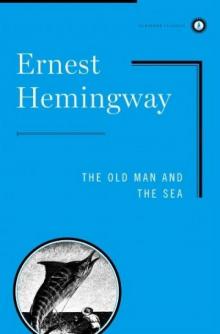 The Old Man and the Sea
The Old Man and the Sea Green Hills of Africa
Green Hills of Africa The Sun Also Rises
The Sun Also Rises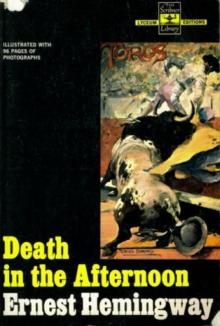 Death in the Afternoon
Death in the Afternoon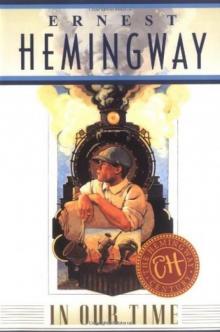 In Our Time
In Our Time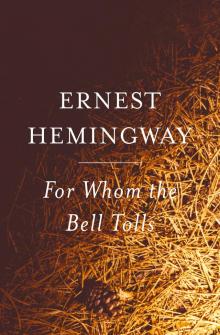 For Whom the Bell Tolls
For Whom the Bell Tolls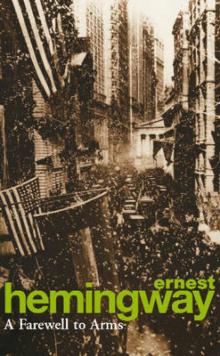 A Farewell to Arms
A Farewell to Arms A Moveable Feast
A Moveable Feast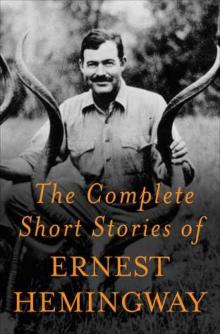 The Complete Short Stories of Ernest Hemingway
The Complete Short Stories of Ernest Hemingway Big Two-Hearted River
Big Two-Hearted River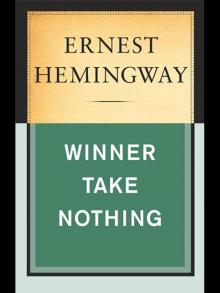 Winner Take Nothing
Winner Take Nothing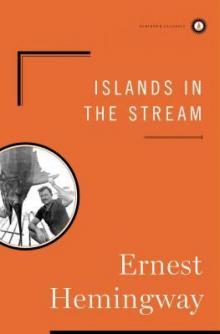 Islands in the Stream
Islands in the Stream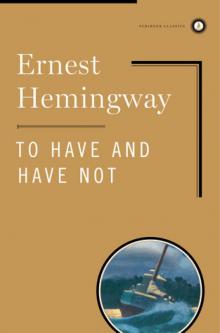 To Have and Have Not
To Have and Have Not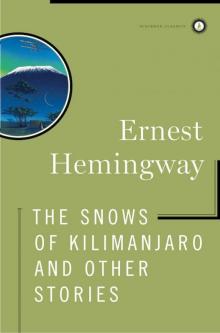 The Snows of Kilimanjaro and Other Stories
The Snows of Kilimanjaro and Other Stories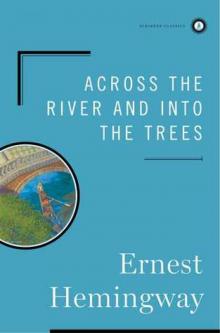 Across the River and Into the Trees
Across the River and Into the Trees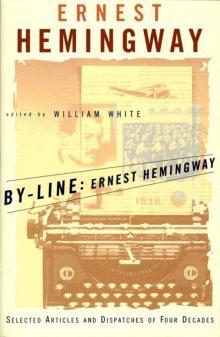 By-Line Ernest Hemingway
By-Line Ernest Hemingway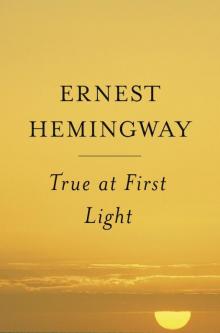 True at First Light
True at First Light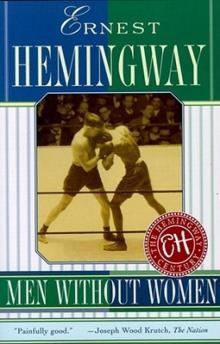 Men Without Women
Men Without Women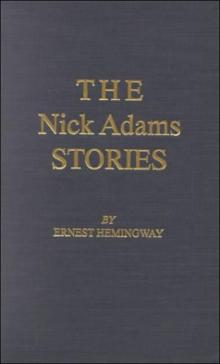 The Nick Adams Stories
The Nick Adams Stories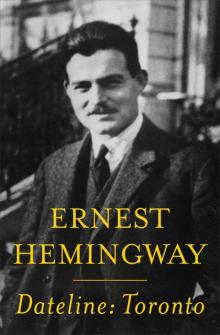 Dateline- Toronto
Dateline- Toronto The Torrents of Spring
The Torrents of Spring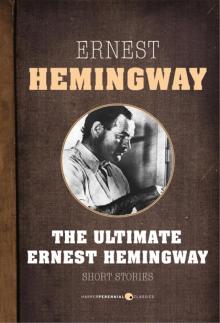 Short Stories
Short Stories